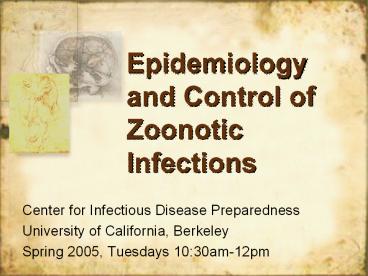Epidemiology and Control of Zoonotic Infections PowerPoint PPT Presentation
1 / 40
Title: Epidemiology and Control of Zoonotic Infections
1
Epidemiology and Control of Zoonotic Infections
- Center for Infectious Disease Preparedness
- University of California, Berkeley
- Spring 2005, Tuesdays 1030am-12pm
2
Instructors
- Ben Sun, DVM, MPVM
- bsun_at_dhs.ca.gov
- Gundula Dunne, DVM, MPVM
- gdunne_at_dhs.ca.gov
- Guest Lectures
- Jason Stull, DVM, MPVM
- Anne Kjemtrup, DVM, MPVM
3
Goals
- Importance of Zoonoses in
- Public Health
- Ecology and Natural History
- Prevention and Control
4
Organization
- 8 Weeks
- Presentation Lecture Questions
- Disease Coverage
- Multiple per lecture
- Examples
- Focus on animal aspects
- See references for additional reading
5
Requirements
- Weekly reading
- Case Report
- Paper
- Oral Presentation
6
Oral Presentation
- Given at beginning of class
- Relevant to the lecture
- 10-15 minutes
- Identify disease
- Background
- Case Investigation
- Discuss Zoonotic Aspects
- Confidentiality (remove identifiers)
- Limited number of spaces
7
Paper
- DUE MARCH 1
- Any zoonotic disease
- Double spaces, font size 12
- No more than 5 pages
- Background
- Case Investigation
- Discuss Zoonotic Aspects
- Need a topic? Ask us
8
Class Schedule
- Week 1 Zoonosis Intro TSE
- Week 2 Rabies
- Week 3 Classic Zoonoses
- Week 4 Bioterrorism
- Week 5 Vector-borne Diseases
- Week 6 Parasitic Zoonoses
- Week 7 Emerging Zoonoses
- Week 8 Foodborne Illnesses
9
Epidemiology and Control of Zoonotic Infections
Lecture 1
- January 18, 2005
10
- Part I Introduction to Zoonoses
- Part II Transmissible Spongiform
Encephalopathies
11
Intro to Zoonoses
- Definition
- Importance
- Etiologies
- Animal Examples
- Transmission Routes
- Life Cycles
12
Zoonoses
- From the Greek
- Zoon Animal
- Noson Disease
- Diseases and infections which are naturally
transmitted between vertebrate animals and humans - - WHO 1959
13
Zoonoses
- Does NOT include
- Fish and reptile toxins
- Allergies to vertebrates
- Diseases in which animal-derived food serves as a
vehicle (e.g. hepatitis A contaminated deli meat) - Experimentally transmitted diseases
14
Zoonoses
- gt 250 zoonotic diseases
- 60 of US Household have 1 pet
- Multiple pets in the home
- Human-animal bond
- Exotic species as pets
15
Zoonoses Common Diseases
- Frequency (CDC, 2003)
- Salmonella 39,919
- Lyme disease 18,991
- West Nile (CNS) 2,862
- Trichinosis 4
16
Zoonoses
- Spectrum of Disease Severity
- Death rabies
- Severe illness plague
- Chronic illness Q-fever
- Mild illness psittacosis
17
Zoonoses Importance
- Economics
- Zoonotic disease are expensive
- Rabies post-exposure prophylaxis
- GI illness due to Salmonella or Campylobacter
lost productivity, medical costs - Import/Export
- BSE restriction on cattle
- Avian Influenza restriction on chicken
- Travel/Globalization
- Decreased transit time - SARS
- Remote area accessibility
18
(No Transcript)
19
Zoonoses Importance
- Surveillance
- Animals are sentinels
- Prevention and Control
- Animal key component
- Complications (e.g. Lyme disease)
- Unknown reservoirs (e.g. Ebola)
20
Zoonoses Etiologic Classification
- Viral
- Bacterial
- Parasitic
- Mycotic
21
Zoonoses Viral Examples
indicates covered in lectures
22
Zoonoses Bacterial Examples
indicates covered in lectures
23
Zoonoses Parasitic Examples
indicates covered in lectures
24
Zoonoses Mycotic Examples
- Aspergillosis
- Blastomycosis
- Cryptococcosis
- Dermatophytosis
- Histoplasmosis
- Sporotrichosis
indicates covered in lectures
25
Zoonoses Animal Species
- Dogs Cats
- Rabies
- Roundworm
- Ringworm
- Lyme Disease (dogs only)
- Cat Scratch Disease (cats only)
- Food Animals
- Salmonella
- E.coli
- Brucellosis
26
Zoonoses Animal Species
- Birds
- Psittacosis
- West Nile
- Cryptococcus
- Reptiles, Fish, Amphibians
- Salmonella
- Mycobacterium
- Wild Animals
- Hantavirus
- Plague
- Tularemia
27
Routes of Transmission
- Direct
- Droplet or Aerosol
- Oral
- Contact
- Indirect
- Foodborne
- Water-borne
- Fomite
- Vector-borne
- Environmental
28
Zoonoses - Life Cycle
- ORTHOZOONOSES
- May be perpetuated in nature by a single
vertebrate species - E.g. rabies, brucellosis, anthrax
29
Zoonosis Rabies Life Cycle
Virus inoculation (bite)
Salivary gland excretion
30
Zoonoses - Maintenance Cycle
- CYCLOZOONOSES
- Requires more than one vertebrate species but no
invertebrate host - Most are cestodiases (tapeworm diseases)
- Taenia saginata and T. solium require man to be
one of vertebrate hosts - Others, such as hydatidosis, man is accidentally
involved
31
Life Cycle
32
Zoonoses - Life Cycle
- METAZOONOSES
- Require both vertebrates and invertebrates to
complete transmission - All arboviral infections
- West Nile virus, Saint Louis encephalitis
- Some bacterial diseases
- Plague, many rickettsia
- Some parasitic diseases
- Leishmaniasis, schistosomiasis
33
Zoonoses Metazoonoses
- Invertebrate Host Mosquitoes
- Vertebrate Host Birds
- Incidental Hosts
- HUMANS, horses, amphibians, other mammals
34
Risk Factors
- Companion Animal
- Dogs roundworm
- Rats Rat Bite Fever
- Occupational
- Animal control workers rabies
- Wildlife biologists hantavirus
- Foodborne
- Raw meat E.coli
- Unpasteurized dairy Listeria
35
Risk Factors
- Recreational Activities
- Camping Lyme disease
- Farm Settings
- Sheep Q-fever
- Cattle Cryptosporidium
- Travel
- Maylasia Nipha
- Australia Hendra
36
Reportable Diseases of Animals
- By veterinarian or other individual
- Reported to CA Department of Health Services
- Plague
- Rabies
- Reportable to the CA Department of Food and
Agriculture - Anthrax
- Brucellosis
- Glanders
- Listeriosis
- Rabies in livestock
- Venezuelan equine encephalomyelitis
- West Nile
- And more
37
(No Transcript)
38
(No Transcript)
39
Zoonosis Take Home Points
- Transmitted between animals and humans
- Zoonoses are common
- Animals part of everyday life
- Recognize the risk factors
40
Acknowledgements
- Dr. Bruno Chomel
- Dr. Ben Sun

